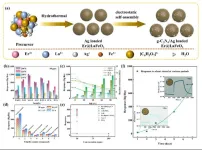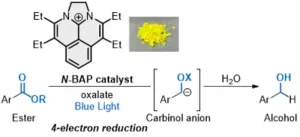(Press-News.org) Highlights:
Mouse studies suggest a link between the gut microbiome and neurodegenerative diseases, but the pathways remain unclear.
New study reports distinct bacterial and metabolite profile in patients with Alzheimer’s disease and other neurodegenerative diseases.
The study flagged the metabolite DHPS as a possible missing link in our understanding of how gut microbes influence NDDs through sulfur metabolism pathways.
Atlanta, Ga.—Neurodegenerative diseases (NDDs), which have no known cures and elusive causes, result in irreversible damage to the brain and nervous system. Research into these diseases typically focuses on the brain, but mouse studies from the last few years suggest that the microbiome plays a role in the onset and progression of some NDDs, as well.
“These findings suggest the gut microbiome plays an important role in the onset and progression of at least some neurodegenerative diseases,”noted Chris Ellis, principal investigator of the multi-institution team of microbiologists from Netellis, the University of Tennessee at Knoxville and the University of North Carolina at Chapel Hill.
At ASM Microbe, the annual meeting of the American Society for Microbiology, those researchers report a new link in humans between a metabolite produced by gut microbes and 3 NDDs. Their analysis suggests that the metabolite DHPS (2,3-dihydroxypropane-1-sulfonate) may help answer critical questions about how sulfur metabolism pathways can connect the microbiome to these diseases.
DHPS has not previously been detected in people, and the researchers noted that metabolites produced by gut microbes in patients with NDDs might offer valuable clues to a better understanding, which could lead to improved diagnostic tools or even treatments.
In previous studies, researchers have found that fecal transplants can alleviate Alzheimer’s disease-like progression in mouse models, and when fecal transplants from people with the disease are administered to mice, the animals experience impairments in memory function.
The researchers undertook the new study to identify distinct bacterial and metabolite profiles of the gut microbiome in people diagnosed with 1 of 3 NDDs: amyotrophic lateral sclerosis (ALS), Alzheimer’s disease (AD), and Parkinson’s disease (PD). To capture data on early-stage disease, they collected stool samples from diagnosed patients within the first 2 visits to a specialist, and they compared analyses of those samples to samples collected from healthy controls.
Their analysis revealed 19 metabolic biomarkers for neurodegeneration in all 3 NDD groups; they also found 20 unique ALS markers, 16 unique AD markers and 9 unique PD markers. Those shared biomarkers included metabolites that have been connected to dyshomeostasis in sulfur metabolism pathways.
In addition, in all 3 disease groups, they found links to Bilophila and Desulfovibrio bacterial taxa, which play a role in synthesizing and degrading DHPS. Those increased levels of Bilophila corresponded to the observation that patients with AD, ALS and PD had lower abundance of DHPS in stool samples, compared to healthy subjects.
Bilophila can degrade DHPS into hydrogen sulfide, and the accumulation of hydrogen sulfide has been implicated in the dysfunction of mitochondria, which is known to contribute to NDDs. Hydrogen sulfide is linked to known NDD hallmarks, including inflammation, oxidative stress and gut dysbiosis.
The authors suggested that the new study flags DHPS as a “missing link” in our current understanding of the mechanisms of how NDDs are linked to sulfur metabolism, mitochondrial dysfunction and neuroinflammation.
###
ASM Microbe is the annual meeting of the American Society for Microbiology, held June 13-17, 2024, in Atlanta, Ga.
The American Society for Microbiology is one of the largest professional societies dedicated to the life sciences and is composed of 36,000 scientists and health practitioners. ASM's mission is to promote and advance the microbial sciences.
ASM advances the microbial sciences through conferences, publications, certifications, educational opportunities and advocacy efforts. It enhances laboratory capacity around the globe through training and resources. It provides a network for scientists in academia, industry and clinical settings. Additionally, ASM promotes a deeper understanding of the microbial sciences to diverse audiences.
END
Sulfur metabolites linked to neurodegenerative diseases
2024-06-15
ELSE PRESS RELEASES FROM THIS DATE:
Insights into the salivary glands
2024-06-15
TLS are accumulations of lymphoid cells that share similar cellular compartments, organization, and function as secondary lymphoid organs. Importantly, the presence of these structures in inflamed salivary glands associated with active disease, increased autoantibody production, and malignancy risk.
“To treat patients effectively, comprehensive understanding of the salivary gland microenvironment is needed”, said Saba Nayar, “but current profiling efforts often struggle to capture high-plex 'omics data while preserving the spatial architecture of the tissue.”
To ...
Holistic approach to care
2024-06-15
The 16-week Plants for Joints trial investigated the effects of a multidisciplinary lifestyle intervention in people with RA, as compared to usual care. The intervention was based on a whole-food, plant-based diet – alongside physical activity and stress management. Previous reports showed this intervention significantly reduced the 28-joint disease activity score (DAS28) compared to usual care alone.2,3 To expand on this, the researchers wanted to determine the long-term effectiveness of the intervention, specifically with ...
Ultra-high sensitivity for isoamyl alcohol based on g-C3N4 nanosheets incorporated Ag nanoparticles loaded Er0.05La0.95FeO3 heterojunctions with enhanced moisture resistance
2024-06-15
The volatile of isoamyl alcohol released from the stored wheat increased with the storage extending, making it one of the potential biomarkers for the early-stage of wheat mildew. Currently, there is a scarcity of chemiresistors for isoamyl alcohol detection, which suffer from low sensitivity. The team of material scientists led by Professor Chao Zhang reported that LaFeO3-based sensing materials demonstrated remarkable sensitivity for isoamyl alcohol (DOI: 10.1039/D3TA05718F, 10.1007/s11666-024-01740-4). However, it’s essential to note that there is still potential for lowering the optimal operating temperature and enhancing moisture ...
Reduction of esters by a novel photocatalyst
2024-06-15
The sweet smell of strawberries and other fruits is thanks to a chemical compound called ester, which is also found in many fats and polyesters. The ubiquitous compound can be broken down to produce desirable alcohols and other chemicals for use across industries including pharmaceuticals and cosmetics, but the process can be costly, both financially and in terms of the environment.
Now, a team of researchers with the National Institutes of Natural Sciences (NINS) in Japan has developed a novel approach using light as an energy ...
Is there a link between increased headaches and hotter temperatures for individuals with migraines?
2024-06-15
As temperatures rise, so do chances for migraine attacks, according to a new study from a team of researchers at the University of Cincinnati College of Medicine, Icahn School of Medicine at Mount Sinai, Errex Inc. and Teva Pharmaceuticals USA. Inc.
“Weather change is one of the most common trigger factors for migraine,” says Vincent Martin, MD, director of the Headache and Facial Pain Center at UC's Gardner Neuroscience Institute and UC Health physician. He is the study’s lead author and president of the National Headache Foundation.
These findings from the study, which looked at use of Fremanezumab and whether it could prevent headaches ...
When bacteria are buckling
2024-06-15
Cyanobacteria are one of the oldest and most important life forms in the world – for example as they took an essential part in producing the oxygen in our atmosphere. Some types form long filaments composed of a few to more than 1,000 individual cells. In this form, the filamentous bacteria can move around. The principles of this locomotion have now been investigated by a research team led by Stefan Karpitschka, group leader at the MPI-DS and professor at the University of Konstanz, in collaboration with the University of Bayreuth and the University of Göttingen.
"We measured the force during locomotion on individual ...
In brief: Multi-omics analysis identifies molecularly defined Alzheimer’s disease subtypes
2024-06-15
Omics analysis is the process of analyzing large data sets to extract meaningful information about biological molecules—genes, DNA, RNA, proteins, metabolites or more—with the goal of illuminating typical molecular pathways and deciphering where things go awry in disease. In a study led by Bruno A. Benitez, MD, a human geneticist and director of the Neurobiorepository in the department of Neurology at Beth Israel Deaconess Medical Center (BIDMC), investigators used machine learning approaches to integrate high-throughput transcriptomic, proteomic, metabolomic, and lipidomic profiles to provide novel ...
New study offers a better way to make AI fairer for everyone
2024-06-15
In a new paper, researchers from Carnegie Mellon University and Stevens Institute of Technology show a new way of thinking about the fair impacts of AI decisions.
They draw on a well-established tradition known as social welfare optimization, which aims to make decisions fairer by focusing on the overall benefits and harms to individuals. This method can be used to evaluate the industry standard assessment tools for AI fairness, which look at approval rates across protected groups.
"In assessing fairness, the AI community tries to ensure equitable treatment for groups that differ in economic level, ...
NRL researchers receive Navy’s Top Scientists and Engineers Award
2024-06-14
WASHINGTON – U.S. Naval Research Laboratory scientists and engineers received the prestigious Department of Navy Dr. Delores M. Etter Top Scientists and Engineers of the Year Award, June 12, during an awards ceremony hosted at the Pentagon.
“The Top Scientists and Engineers of the Year award program recognizes and acknowledges the excellence of our highest performing scientists and engineers in support of the Department of the Navy," said Frederick J. Stefany, Assistant Secretary of the Navy for Research, ...
CDC-funded program improved cardiovascular health of Nebraska women
2024-06-14
Waltham — June 14, 2024 — When implemented in Nebraska, the WISEWOMAN program supported by the Centers for Disease Control and Prevention (CDC), which offers services for women ages 40–64 who are low-income and uninsured/underinsured, improved hypertension, blood pressure self-management, diet, physical activity, and body weight. Jianping Daniels, PhD and colleagues, of the Nebraska Department of Health and Human Services, detail these findings in a supplement to the Journal of Public Health Management and Practice, published in the Lippincott portfolio by Wolters Kluwer.
In an introduction ...




